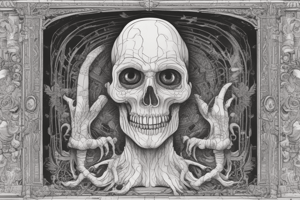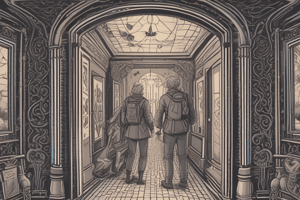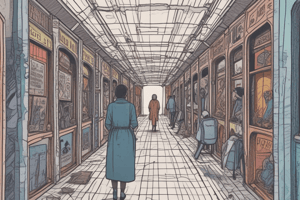Podcast
Questions and Answers
Match the psychological concept with its description:
Match the psychological concept with its description:
Mortality Salience = Fear of death that motivates human behavior Social Cure = Groups can be a source of support and protection Realistic Conflict Theory = Explains how intergroup conflicts arise from conflicting interests Stigma = A characteristic that marks a person for social devaluation
Match the researcher with their contribution:
Match the researcher with their contribution:
Campbell = Defined Realistic Conflict Theory Sherif = Conducted classic field experiments on intergroup conflict Brown = Defined stigma as a characteristic that marks a person for social devaluation Crocker = Showed that attributing negative outcomes to prejudice can help maintain self-esteem
Match the concept with its effect:
Match the concept with its effect:
Stigma = Leads to negative experiences, such as exclusion and low self-esteem Social Cure = Linked to reduced depression, increased control, and better health Mortality Salience = Motivates human behavior and can lead to opposing effects Realistic Conflict Theory = Explains how intergroup conflicts arise from conflicting interests
Match the study with its finding:
Match the study with its finding:
Match the term with its description:
Match the term with its description:
Match the psychological concept with its related concept:
Match the psychological concept with its related concept:
Match the researcher with their contribution:
Match the researcher with their contribution:
Match the psychological concept with its effect on well-being:
Match the psychological concept with its effect on well-being:
Match the study with its limitation:
Match the study with its limitation:
Match the psychological concept with its impact on relationships:
Match the psychological concept with its impact on relationships:
Match the researchers with their contributions to the field of Terror Management Theory:
Match the researchers with their contributions to the field of Terror Management Theory:
Match the psychological concepts with their descriptions:
Match the psychological concepts with their descriptions:
Match the theories with their explanations:
Match the theories with their explanations:
Match the condition of the Contact Hypothesis with its description:
Match the condition of the Contact Hypothesis with its description:
Match the researchers with their findings:
Match the researchers with their findings:
Match the researcher with their contribution to the Contact Hypothesis:
Match the researcher with their contribution to the Contact Hypothesis:
Match the concepts with their explanations:
Match the concepts with their explanations:
Match the research findings with their descriptions:
Match the research findings with their descriptions:
Match the concept with its description:
Match the concept with its description:
Match the limitation of the Contact Hypothesis with its description:
Match the limitation of the Contact Hypothesis with its description:
Match the concepts with their explanations:
Match the concepts with their explanations:
Match the concepts with their explanations:
Match the concepts with their explanations:
Match the criticism of the Contact Hypothesis with its description:
Match the criticism of the Contact Hypothesis with its description:
Match the study with its finding:
Match the study with its finding:
Match the researcher with their concept:
Match the researcher with their concept:
Match the limitation of the Contact Hypothesis with its description:
Match the limitation of the Contact Hypothesis with its description:
Match the concept with its description:
Match the concept with its description:
Match the study with its finding:
Match the study with its finding:
Match the term with its definition:
Match the term with its definition:
Match the factors that contribute to genocide with their descriptions:
Match the factors that contribute to genocide with their descriptions:
Match the psychological consequences of genocide with their effects:
Match the psychological consequences of genocide with their effects:
Match the cultural-societal characteristics that contribute to genocide with their descriptions:
Match the cultural-societal characteristics that contribute to genocide with their descriptions:
Match the role of bystanders in genocide with their actions:
Match the role of bystanders in genocide with their actions:
Match the experiment with its findings:
Match the experiment with its findings:
Match the effects of genocide on individuals with their consequences:
Match the effects of genocide on individuals with their consequences:
Match the terms with their descriptions:
Match the terms with their descriptions:
Match the factors that contribute to the continuum of destruction with their effects:
Match the factors that contribute to the continuum of destruction with their effects:
Match the effects of bystander behavior with their consequences:
Match the effects of bystander behavior with their consequences:
Match the following types of bystanders with their characteristics:
Match the following types of bystanders with their characteristics:
Match the following theories with their authors:
Match the following theories with their authors:
Match the following concepts with their descriptions:
Match the following concepts with their descriptions:
Match the following strategies with their descriptions:
Match the following strategies with their descriptions:
Match the following researchers with their contributions:
Match the following researchers with their contributions:
Match the following concepts with their effects:
Match the following concepts with their effects:
Match the following limitations with their descriptions:
Match the following limitations with their descriptions:
Match the following concepts with their related concepts:
Match the following concepts with their related concepts:
Match the following historical events with their descriptions:
Match the following historical events with their descriptions:
Match the following concepts with their effects on well-being:
Match the following concepts with their effects on well-being:
Flashcards are hidden until you start studying
Study Notes
Terror Management Theory (TMT)
- Proposed by Solomon et al. (1991) to explain the human need for self-esteem
- People are motivated to maintain a positive self-image because self-esteem protects them from anxiety
- Self-esteem serves as a buffer against death anxiety
- TMT proposes that the link between self-esteem and protection from anxiety develops in early childhood through interactions with parents
- Parent's love and protection can show goodness and value, which can help children internalize these standards
- Meeting these internalized standards (self-esteem) becomes associated with feelings of safety and security
Research Supporting TMT
- Greenberg's study: increasing self-esteem reduces anxiety and defensiveness in response to threatening stimuli
- Study: mortality salience (MS) increases the need for faith in one's worldview
Criticisms of TMT
- Questioning whether fear of death is a universal motivating force
- Alternate explanations for MS effects, such as motives for uncertainty reduction, meaning, and belonging
- MS can lead to opposing effects
Stigma and Well-being
- Stigma: any characteristic that marks a person for social devaluation
- Stigma can lead to negative experiences, including anger, anxiety, low self-esteem, stress, and shame
- Coping strategies: restricting comparisons to within-group members, disengaging from dimensions, and attributing negative outcomes to the prejudice of others
- Attributing negative outcomes to prejudice can help maintain self-esteem, but may not always be protective
- The Social Cure: group identification can be an important source of support and help protect against negative experiences
Realistic Conflict Theory (RCT)
- Proposed by Campbell: people's attitudes towards ingroup and outgroup members reflect the objective interests of the ingroup
- RCT assumes that:
- If interests of two groups coincide, relations between groups will be relatively harmonious
- If there is conflict between the two groups, relations between groups will become hostile
- Evidence Supporting RCT:
- Explains various conflicts, such as those between men and women, Palestinians and Israelis, Catholics and Protestants, and racial groups
- Economic competition has been linked to intergroup violence
- RCT can account for historical specificity of prejudice
- Criticisms and Limitations:
- Methodological issues with Sherif's studies
- RCT may oversimplify the causes of intergroup conflict
- Assumes conflict is always perceived as a zero-sum game
The Contact Hypothesis
- Proposed by Allport (1954): intergroup conflict can be reduced by bringing groups into contact under certain conditions
- Conditions:
- Equal status
- Common goals
- Intergroup cooperation
- Support of authorities
- Acquaintance or friendship potential
- Evidence Supporting the Contact Hypothesis:
- Early evidence: desegregation of the merchant marine in 1948
- Studies of white housewives in desegregated housing projects
- Recent evidence from various groups
- Meta-analysis: significant effect size across 714 independent samples and 250,000 people
- Evidence:
- Extended contact, vicarious contact, and imagined contact have also been shown to reduce prejudice
- The Secondary Transfer Effect: contact between two groups can lead to reduced prejudice towards other ethnic minorities
- Criticisms and Limitations:
- Assumption that contact reduces prejudice through reduced ignorance has been questioned
- Generalization of effects has been a concern
- Typicality of outgroup members in contact situations is important for generalization
- Debate about the psychological processes involved in contact
Genocide and the Holocaust
- Genocide: an attempt to exterminate a group by creating conditions that lead to the group's destruction
- Mass killing: killing group members without the intention to eliminate the whole group
- Holocaust: 6 million Jews killed, 5 million others killed
- Factors contributing to genocide:
- Difficult life conditions
- Certain cultural-societal characteristics
- Continuum of destruction
- Psychological consequences:
- Threat to self-concept
- Feeling disorganized and anxious
- Resolving the problem of genocide can lead to turning against outgroups
- Bystanders:
- Can change as a result of their actions
- Can distance themselves from the victim and think they deserve their fate
- Help prop up the system and allow genocide to happen
- Internal and external bystanders
Social Identity Theory (SIT)
- Developed by Tajfel and Turner: aims to explain intergroup behavior and discrimination
- Key assumptions and processes:
- Social categorization to simplify the complex social world
- Formation of a 'social identity' or 'social self'
- Inherent need to evaluate the self positively
- Comparisons with relevant outgroups lead to a positive social identity and self-esteem
- Evidence Supporting SIT:
- Studies provide support for SIT's predictions regarding the link between social identity and intergroup discrimination
- Criticisms and Limitations:
- Relationship between self-esteem and intergroup discrimination is more complex than initially proposed
- SIT does not always predict intergroup discrimination as a means of enhancing self-esteem
- Theory's predictions may not hold in all contexts
Studying That Suits You
Use AI to generate personalized quizzes and flashcards to suit your learning preferences.




